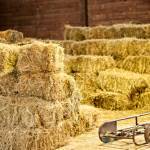Sampling Horse Forage

Knowing what your horses are actually eating is not always easy. Sampling forages presents a challenge, especially when sampling fresh forage or pasture. A hay core should be used to get a meaningful hay sample for analysis. Hay cores are available that may be attached to a hand-held (brace and bit) or electric drill. Owners may be able to borrow one of these appliances from the local feed store or agricultural extension office.
Square bales of hay should be sampled diagonally across the long axis of the bale rather than directly through the center. This direction is more critical for sampling legume or mixed grass-legume hays than for single-species grass hays. During the baling process, leaves are shattered and may fall to the bottom of the baling chamber. Thus, the diagonal sampling technique should provide an artificial remixing of the stem and leaf and a more representative sample of the material actually available to the horse.
Many times, multiple cores must be taken to obtain an adequate sample for analysis. To get the most accurate analysis when sampling hay, one should sample four to six bales taken from different parts of the stack. After taking hay samples, it is important to keep any core-sampled bales outside the barn for several hours because the process produces some heat and sampled bales can potentially start a fire.
Pasture analysis is even more perplexing than the sampling of other feedstuffs. The basic question that must first be addressed is whether the entire pasture should be systematically sampled or if only those areas that are the most heavily grazed should be sampled. As horses are spot grazers, tending to graze in the lawns and defecate in the roughs, it is probably more accurate to sample the forage actually eaten to get an assessment of the forage quality that contributes significantly to the nutrient intake of the horse.
Additionally, unless the pasture growth is only one species of forage, one must try to make sure that the species of forages sampled are those that the horses select when grazing. This attempt is best done by examining the pasture, observing grazing behavior, and then sampling the turf as horses appear to graze. Because of the high moisture level in many fresh forages (50-85%), a sample of at least a pound (0.5 kg) of fresh forage must be taken to ensure that adequate dry matter is available for analysis. To control the changes in composition that naturally occur once grass has been cut, the sample should be frozen immediately after being taken before being sent to a lab for analysis.








